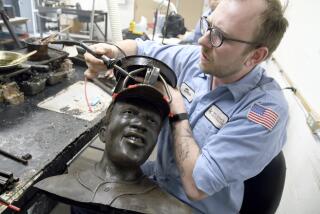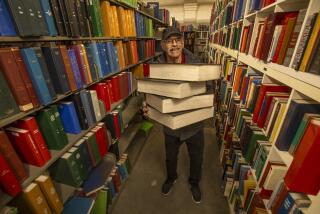A Glut of Remington Replicas Taxes Trade : Sculpture: Prices have plunged for knockoffs of the Western artist’s bronze statues, which are in the public domain.
- Share via
Artworks are commodities. And like cotton, soybeans and pork bellies, when there’s a glut of products on the market, prices take a nose dive. Consider what’s happened in recent years to knockoff copies of bronze statues by 19th-Century Western artist Frederic Remington.
Last year, prices fell 25% for replicas of Remington’s Wild West statuettes, and two local firms that specialize in Remingtons have redoubled their sales efforts to stay in business.
“There’s a lot more competition today,” griped Greg Golob, owner of Foundry Bronzes in Sherman Oaks, which manufactures and sells bronze Remington copies. Golob said the past two years have been his worst in 16 years of business.
The price war is hurting Will Munyon too, who sells Remingtons through his mail-order business in Thousand Oaks. Last year, Munyon slashed his prices 25%, but it didn’t make much difference--his sales for the year dropped 10%, after having slipped 10% in 1991.
The problem? “There are tons of Remington replicas out there,” said Lowell McAllister, executive director of the Frederic Remington Art Museum in Ogdensburg, N. Y.
The excess supply exists because Frederic Remington (1861-1909) is long gone and any copyrights on his works have fallen into the public domain. McAllister said he doesn’t even know the number of dealers of Remington knockoffs, “and there’s no way of knowing how good they are.”
Remington’s original bronze castings vividly recreated the Wild West with romanticized figures of broncobusters, noble Indians and lonely cowpokes. In the late 1980s, some replicas of Remington bronzes were selling for as much as $4,000. Today, you can buy one for as little as $350. And a desktop Remington statue can cost as little as $90.
It forces veteran Remington dealers such as Golob and Munyon, who sell three-to-five foot, full-sized replicas of Remington’s bronzes, to try and keep their costs low and hunt extra hard for customers willing to pay from $400 to $3,500 per statue.
Despite the slump, they each claim to generate $500,000 in annual sales of Remington replicas and other bronze statues. “Today, people are more skeptical and take their time buying,” Munyon said. The sluggish economy has helped depress sales, added Golob.
But the biggest problem is the glut of Remington replicas. Some manufacturers, Munyon and Golob complain, cut costs by rapidly producing low-quality bronze products, which further lowers prices.
In Remington’s time, recasts of his artworks were made from the original molds, which could be used dozens of times. But today, some foundries make their replicas from a copy of a recast. “It’s like taking a photocopy of a photocopy,” said McAllister. “You lose the details that make a picture clear.”
Because few foundries sign their work, few buyers know exactly how a replica was made.
This vagary makes for a wide range of quality in the replica market, said McAllister. “For people who just want a nice decoration in the foyer, a replica is fine. But don’t use your children’s college tuition to buy one and expect it to appreciate in value.”
Munyon and Golob, who don’t know each other, run two very different businesses.
Munyon, whose company is called Munyon & Sons, runs strictly a Remington mail-order business. He got his start in 1979, selling imported Korean products at swap meets. One weekend, he sold a bronze figure of a dog and made a $75 profit. “That was the most profit I had ever made on an item,” so he decided to concentrate on bronzes.
Then Munyon bought a $500 advertisement in the Wall Street Journal. The ad helped him sell a 15-piece collection of Remington replicas for $25,000.
The first year, Munyon sold $150,000 worth of bronzes that he had bought from a distributor who, in turn, had purchased them from a foundry. All of Munyon’s sales stemmed from responses to ads that he had placed in business publications.
He sold primarily to executives who wanted to display bronze figures in their offices or homes. Most of his customers lived outside California. “People in the East love anything Western,” Munyon said.
In 1985, Munyon produced a color catalogue and was advertising regularly in The New Yorker magazine and had a list of customers he’d mail letters to detailing special offers. But competition grew, forcing Munyon to sell higher-quality pieces, he said. He started buying unfinished pieces directly from a foundry, rather than from a distributor.
He now has four employees to grind and sand the details into the bronze figures. They polish and ship pieces from a small warehouse in Thousand Oaks. Today, Munyon answers the phone, does mailings and spends about $50,000 a year on national advertising. “Advertising is key to the success of my business,” he said.
However, given the perils of the business, he’s not sure his two sons will eventually join him.
Golob, on the other hand, runs a small store in Sherman Oaks that sells bronze knockoffs of Remington and other artists.
In 1976, he was working at his father’s lighting business in the Los Angeles Mart when he sold his first Remington copies. “I realized I would rather sell bronzes than just lamps,” he said. With $50,000 in savings, he bought rubber molds of Remington statues from artist Max Turner, who claims to have made the molds from original Remington casts, said Golob.
Golob set up his own foundry in downtown Los Angeles near his showroom. He sold bronzes and light fixtures to furniture- and gift-store owners.
Business was steady until 1984, when Golob took his bronze collection of Remington knockoffs on the road. He started in Albuquerque, N. M., where he placed newspaper ads announcing that his one-man show was coming to a hotel. “I was scared in the beginning, because I had to lay out my own money,” Golob said. “I didn’t know if a show like this would work.” But in four days, he sold $40,000 worth of bronze pieces.
About 70% of his sales used to come from these roadshows, where his biggest clients are interior decorators and furniture buyers. In 1991, he put on 35 one-man shows. “I really like crossing the country, because there are so many different people. People in the South like to take their time with a purchase, and people in the East decide to buy on the spot.”
After the Los Angeles riots last spring, Golob moved his Los Angeles showroom and foundry to a larger place on Ventura Boulevard in Sherman Oaks. His five employees cast and finish the bronze replicas in the foundry, where Golob said he can control the quality.
But the cost of Golob’s roadshows has doubled, and sales prices have dropped. So Golob is switching strategy and isn’t planning to travel this year. Instead, he hopes that his network of clients--furniture stores and gift buyers--will help him make the transition to selling primarily out of his Sherman Oaks store.
His overhead totals $100,000 a year, and he also sells on credit, and those accounts receivable are growing. “People are having a harder time paying their bills, and the new housing market is pretty dead.” The poor housing market means that interior decorators and furniture stores, once his biggest customers, aren’t buying as much these days.
“It’s hard to believe that someone else is making it in this business,” Golob added, referring to Munyon.
To increase sales, Golob will add more products, such as a miniature, desktop line of Remington replicas (price $275) that sold well last year.
As for Munyon, he is going on the road and plans to travel to Europe in hopes of increasing his sales.
Casting Art Works
Art objects have been cast in metals dating back to 2250 BC. Current replicas of Frederic Remington’s 19-Century Western statues are made by applying coats of rubber onto an original Remington cast, or some foundries make their replicas from a copy of a recast.
Either way, the first step is to use a rubber mold as a model, after which a foundry worker casts a wax positive. The wax sculpture is then dipped into ceramic until a shell forms. Next, the ceramic is baked until the wax melts, leaving space inside the shell.
A foundry worker then pours bronze inside the shell. When the metal cools, the shell is broken to reveal a bronze sculpture intact, ready for final detailing, polishing and shipping.
More to Read
Inside the business of entertainment
The Wide Shot brings you news, analysis and insights on everything from streaming wars to production — and what it all means for the future.
You may occasionally receive promotional content from the Los Angeles Times.










